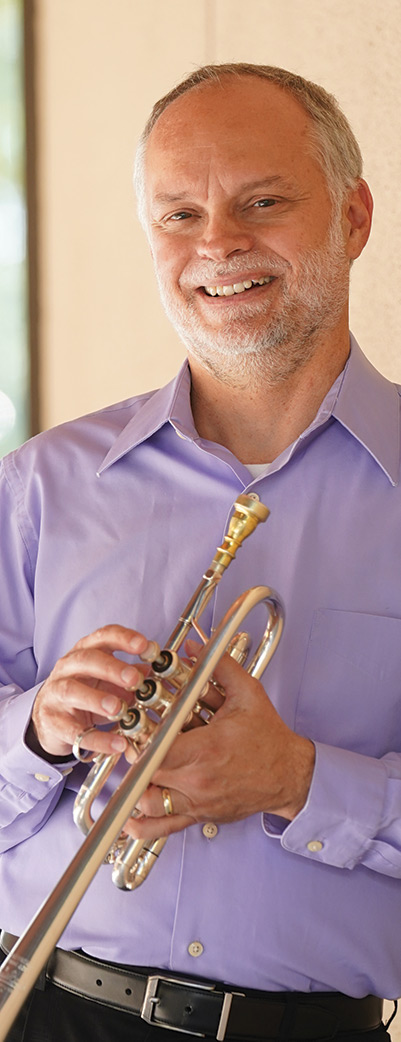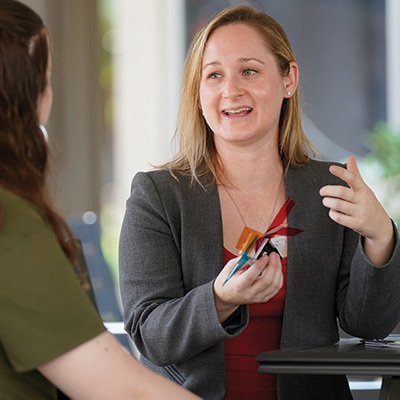 Music professor Jeffrey S. Wilson watches the future develop as he walks by a construction site on the main FPU campus.
Music professor Jeffrey S. Wilson watches the future develop as he walks by a construction site on the main FPU campus.
Wilson, D.M.A., music program director and director of choral activities, joined the faculty during the COVID-19 shutdown and made the best of teaching and mentoring students mainly via Zoom. At the same time, his frequent strolls around campus allow him to monitor progress on the Warkentine Culture and Arts Center (CAC) that will unite the university’s art, music and theater programs under one roof.
To be fully occupied in winter 2022, the emerging building will provide 26,000 square feet of critically needed space such as a multi- purpose auditorium, a black box theater, an art gallery and back-of-the house necessities like dressing and practice rooms. With those new amenities, it will also offer something more: a fresh venue and opportunities for mentoring students.
Dramatic changes
“Things will change dramatically” when the center opens, Wilson says. “Having a place on campus for rehearsal and performance, I think that will help students feel more like that is their home and this is part of Fresno Pacific University and who we are.”
Wilson and other professors consider mentoring a natural and vital part of their everyday job. It can take many forms— academic, spiritual, personal—and happen in individual, small- or large-group settings, on a tour bus or over a meal.
“There is a certain amount of professional mentoring as educators,” Wilson says. “But there is also a personal mentoring that is going on and that is an important part of Fresno Pacific University. We are interested in more than just what you can do—we are interested in who you are and how you can be a good leader and servant wherever it is that you end up.”
George Dougherty, D.M.A., director of bands and coordinator of instrumental music, appreciates how the university’s Christian worldview guides mentoring approaches. After all, he says, “Jesus was a master teacher and mentored 12 disciples— and they went out and changed the world.”
 Most professors think mentoring styles won’t change much in the future. Technology may offer new avenues—Wilson was surprised at how well he got to know his students by Zoom, for example— but in-person interactions are likely to remain the constant.
Most professors think mentoring styles won’t change much in the future. Technology may offer new avenues—Wilson was surprised at how well he got to know his students by Zoom, for example— but in-person interactions are likely to remain the constant.
“I think the possibilities of change will probably reflect changes in culture, changes in technology,” Dougherty says. “But at the core, we will always be mentoring person-to-person. There is always that strength there.”
The CAC will become a foundation for those connections. Mentoring can take place during practice, lessons and rehearsal, during the creation or installation of artwork and in the simple rhythms of life.
Igniting creativity
Brandi Martin, M.F.A., assistant professor and program director in theater, wants to make a lasting impression as a mentor; a concept she carries forward from one of her mentors. “You help ignite or fan the flames of someone else’s light, and that allows them to pass the torch to someone else,” she says.
Martin, who also joined the faculty during the pandemic shutdown, describes her mentoring style as holistic and individual. “What I love about Pacific is that we have the time and the ability to really interact with the students one-on-one,” she says. She meets with students individually to ask about their educational goals and interests. Sometimes a student arrives with the idea of performing, but finds they are drawn to design or directing.
 Having dedicated space in the center where experimentation and exploration can take place will aid the mentoring process. “The students already have within them their purpose and their talents that God will use to bless the world around us,” Martin says. “It’s only my job to help them discover what that is. Ultimately, we want the students to know that they are loved, that they are capable and that they are everything they need.”
Having dedicated space in the center where experimentation and exploration can take place will aid the mentoring process. “The students already have within them their purpose and their talents that God will use to bless the world around us,” Martin says. “It’s only my job to help them discover what that is. Ultimately, we want the students to know that they are loved, that they are capable and that they are everything they need.”
Christa Pehl Evans, Ph.D., assistant professor of music, teaches general education classes along with courses specific to music majors. She sees herself as a mentor to all students, whether that occurs in groups, in individual sessions, over the phone or in other settings.
“I have close relationships with students, even after graduation,” she says. “I really do care about the whole person.”
 Mentoring across disciplines
Mentoring across disciplines
In part, Evans helps students see that the skills they master—such as receiving and processing feedback—can be used in any discipline. As for the new Warkentine Culture and Arts Center, Evans looks forward to a home that provides for the arts and greater opportunities for collaboration. “It’s so important to have places to perform and to bring in artists, and to make Fresno Pacific a beacon (for the arts),” she says.
Chris Janzen, M.F.A., assistant professor of art, also mentors students from all walks of academic life. “I get to know students in a more meaningful, in-depth way because my classes are smaller,”
he says.
Even in a general education class, he tailors
his feedback and critique so that it arrives with personal impact for an individual student. Janzen says he meets students who are involved in all kinds of academics and athletics—from natural sciences to volleyball—and helps relate art to their pursuit. “If you can think creatively in whatever field you go into–that is a most essential skill,”
he says.
In mentoring students planning for a career in studio art, graphic design or other arts field, Janzen helps students identify both strengths and weaknesses. He says there is a place for everyone who practices art at their highest level of excellence.
Yet not all mentoring is academic or strictly related to a career path. Sometimes, Janzen says, a student needs someone to talk to about other issues or stressors in life. “Mentoring can move in different directions,” he says. “I’m just trying to do what my professors and advisers modeled for me when I had difficulties as a college student. We all need someone to listen sometimes.”
A game-changer for the arts
Janzen describes the CAC as a game-changer for the visual and performing arts. The building opens up a whole world of possibilities for the students, campus and community—and for mentoring.
For example, some art majors must prepare artwork for display as part of their coursework. Creating that artwork is one task, but making it ready for the public is another challenge. That is a difficult process to communicate in the classroom, and much easier to navigate with the help of a mentor at their elbow in a campus gallery, Janzen says.
That is just one of many future benefits to the Warkentine Culture and Arts Center now under construction. “You learn about artwork in art history, you get some experience in making artwork, but I think that the mentoring that happens one-on-one carries more weight when there is a place on campus where the community can engage in the discussion,” he says.

